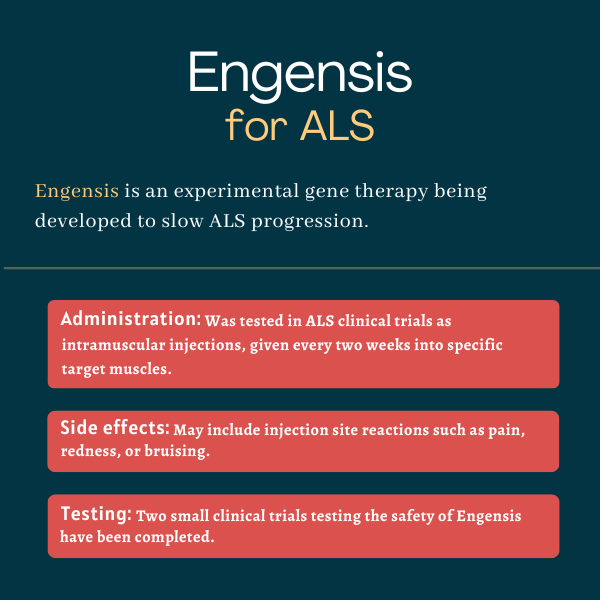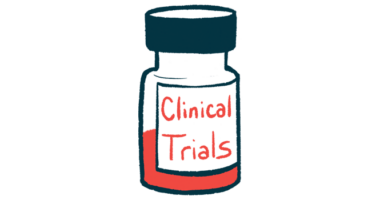Engensis for ALS
Last updated Aug. 7, 2024, by Marisa Wexler, MS

What is Engensis for ALS?
Engensis, also known as VM202, is an investigational gene therapy that aims to slow the progression of amyotrophic lateral sclerosis (ALS). It is given by regular injections into muscle, called intramuscular injections.
The therapy is being developed by Helixmith, formerly known as ViroMed, and it has received both orphan drug and fast track designations for the treatment of ALS. Both provide certain incentives to speed the development and potential approval of therapies.
Engensis also is being investigated across a range of conditions characterized by nerve damage or deficits in circulation, including diabetic neuropathy, coronary artery disease, and Charcot-Marie-Tooth disease.
Therapy snapshot
| Treatment name: | Engensis |
| Administration: | Intramuscular injections |
| Clinical testing: | Completed early safety studies |
How does Engensis work in ALS?
ALS is characterized by the progressive loss of motor neurons, the specialized nerve cells that control voluntary muscles, resulting in muscle weakness and loss of motor control.
Engensis is a nonviral gene therapy that uses a plasmid — a small circular DNA molecule — to deliver the HGF gene directly to patients’ nerve and nerve-supporting cells.
The HGF gene provides the instructions to produce hepatocyte growth factor (HGF), a protein that helps promote the formation of new blood vessels (angiogenesis), prevent muscle shrinkage, and boost nerve cell survival and growth. Its role in promoting motor neuron survival is well documented, and increasing its levels in ALS patients is expected to slow the loss of these neurons.
Engensis contains the instructions for two HGF forms, one consisting of 728 amino acids (the building blocks of proteins) and the other, known as deleted HGF, containing 723 amino acids. A combination of both forms is believed to drive angiogenesis and nerve regeneration more effectively.
The therapy is injected directly into selected muscles to regenerate both damaged motor neurons and muscles. Because the genetic sequence in the plasmid is not introduced into a patient’s DNA and eventually degrades, however, regular injections are needed to sustain HGF protein production.
By boosting HGF production, it’s thought that Engensis may slow or stop ALS progression. Studies in mouse models of ALS showed that increasing HGF production in the nervous system lessened motor neuron degeneration and increased the mice’s life span.
How will Engensis be administered in ALS?
Engensis is designed to be administered via intramuscular injections. In early clinical trials, injections were given into multiple muscle groups weekly or two weeks apart, at total doses ranging from 64 mg to 192 mg.
Engensis in ALS clinical trials
Engensis to date has been tested in ALS patients in two small clinical trials, both of which were mainly designed to assess the therapy’s safety profile.
Phase 1/2 trial
The open-label Phase 1/2 clinical trial (NCT02039401) evaluated Engensis’ safety and tolerability in 18 adults with ALS, ages 21 to 75, whose symptoms had appeared up to two years before enrollment. Participants received weekly intramuscular injections of Engensis for four weeks — alternating between muscles of the arms and legs — and were followed for up to nine months.
All received a total of 64 mg of Engensis over the treatment period, with one group of patients starting with injections in leg muscles, and the other with injections in arm and hand muscles. Most were receiving a stable dose of the ALS treatment riluzole (sold as Rilutek among other names).
Except for one patient who died of ALS complications after seven months, all participants completed the study. Results showed that Engensis was generally safe and well tolerated, with no serious side effects related to the gene therapy.
Although this study was designed mainly to assess the therapy’s safety, some promising efficacy trends were seen. Specifically, measures of functional ability and muscle strength and shrinkage tended to stabilize in the first three months following Engensis treatment, which contrasts with the typical ALS progression in which these measures get steadily worse over time.
After three months, these measures declined at rates similar to those observed before treatment, highlighting the need for routine injections to sustain the treatment’s benefits.
Phase 2a REViVALS-1A study
Following positive Phase 1/2 trial results, Helixmith launched a Phase 2a trial called REViVALS-1A (NCT04632225) to further explore the safety and tolerability of Engensis. The trial enrolled 18 people with ALS, ages 18 to 80, who had been experiencing symptoms affecting their limbs for four or fewer years.
Participants were randomly assigned to receive three cycles of either Engensis or a placebo, given two months apart. Each cycle consisted of two days of injections, spaced two weeks apart, where a total of 128 injections of Engensis or a placebo were administered to target muscles in patients’ arms and legs.
Each treatment cycle delivered a total of 64 mg of the therapy, for a total dose of 192 mg across all three cycles. Patients also could continue on their stable dose of riluzole and/or Radicava (edaravone) during the trial.
The REViVALS-1A study began enrolling participants in 2021, and patients were followed for at least six months. Top-line results, announced in 2022, showed the therapy was well tolerated overall, with no serious side effects related to Engensis reported. Overall rates of adverse events also were comparable in patients given the gene therapy or a placebo.
Because the REViVALS-1A study was quite small, and four participants chose to leave the study early, it wasn’t possible to make reliable comparisons on measures of efficacy between patients on placebo or Engensis.

Common side effects of Engensis
In clinical trials, the most commonly reported side effects of Engensis were injection site reactions such as:
- bruising
- soreness
- redness
- pain.
ALS News Today is strictly a news and information website about the disease. It does not provide medical advice, diagnosis or treatment. This content is not intended to be a substitute for professional medical advice, diagnosis, or treatment. Always seek the advice of your physician or other qualified health provider with any questions you may have regarding a medical condition. Never disregard professional medical advice or delay in seeking it because of something you have read on this website.
Recent Posts
- For the new year, I choose to live in the present and move forward
- FDA clears pivotal Phase 3 trial of new ALS oral therapy pridopidine
- SOD1-ALS therapy Qalsody moves closer to public funding in Canada
- Genetic activity in blood could help detect ALS, predict survival: Study
- I learned to really cherish holiday moments when ALS appeared
Related articles






